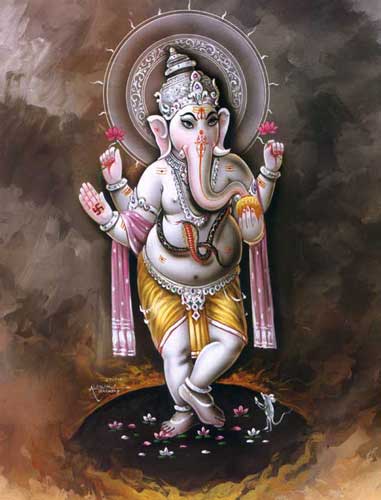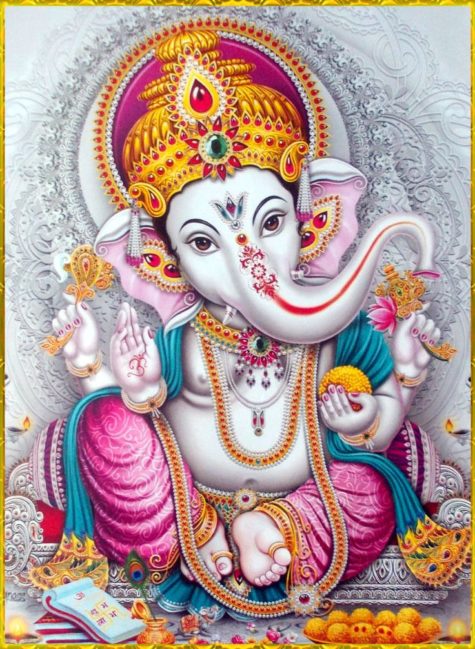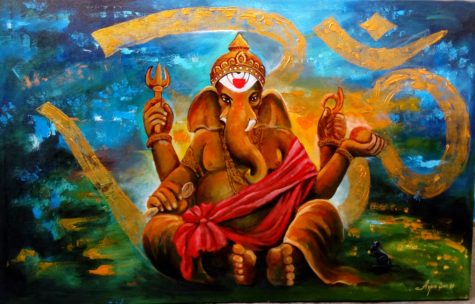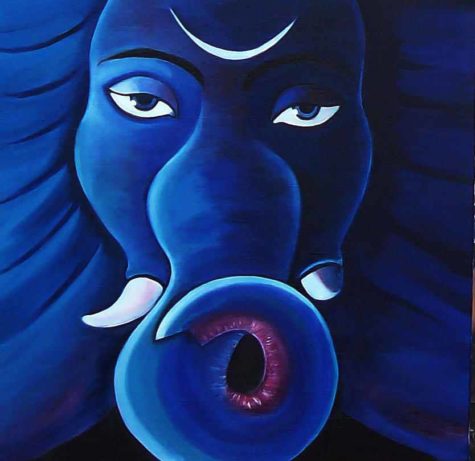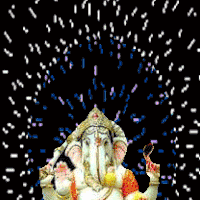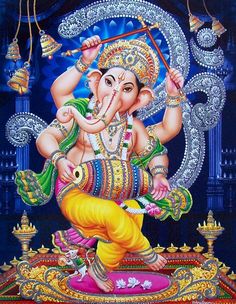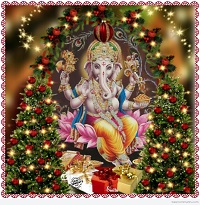A Small Poem
A Hymn To Ganesha
A Renowned Five-Jeweled Hymn by
Sri Adi Sankara (798-820)
Free-Flowing Translation by J. Sethuraman
Maha Ganesa Pancharatna Stotram
I bow to Vinayaka
Who, with glee, holds a half-eaten modaka in His hand,
Who is the ever-present means of moksha
Who has the moon as an ear ornament,
Who protects all the worlds,
Who is the single leader for those who are lost without anybody to help them,
Who destroyed the elephant demon and
Who swiftly removes the blemishes of those who bow to Him.
I seek refuge of the great Lord Vinayaka
Who is higher than the highest,
Who is everlasting,
Who is ferocious to others than those that bow to Him,
Who is resplendent as the newly rising sun,
Worshiped by both demons and Gods,
The savior of those that bow to Him from all their miseries,
The lord of all the Gods,
The lord of all wealth,
The elephant God,
And Ganesvara, the lord of the ganas.
I bow to the resplendent one
Who bestows peace to all the worlds,
Who conquered the elephant demon,
Who has not a small belly,
The excellent one,
Who has a beautiful elephant face,
Who is eternal,
Who is kind,
Who is forgiving,
Who gives happiness,
Who bestows fame and
Who satisfies every wish of those that bow to him.
I worship the ancient elephant God
who shares the misery of the poor,
the fit receptacle of all the ancient prayers,
the first son of the enemy of the three cities (Shiva),
the shatterer of the pride of the demons,
the fierce destroyer of the worlds,
decorated by fire and other elements, and
whose elephant cheeks are flowing with must
(the rut that flows from the cheeks of male elephants.)
I constantly think of Him alone,
the single-tusked one,
With a lovingly brilliant tusk,
The son of the destroyer of the sacrifice (Shiva),
With a form that cannot be comprehended,
With no end,
Who tears asunder all doubts, and
Who is verily like spring to the yogis who hold Him in their hearts all the time.
One who repeats every day
The Maha Ganesha Pancharatna Stotram
With reverence
In the mornings or evenings
while holding Ganesvara in his heart
He, very quickly,
Will be joined by
Good health, blemishlessness, good fellowship, good children, long life,
and the eight vibhutis (powers).
from Loving Ganesa
by Satguru Sivaya Subramuniyaswami
Making A Shrine To Ganesha
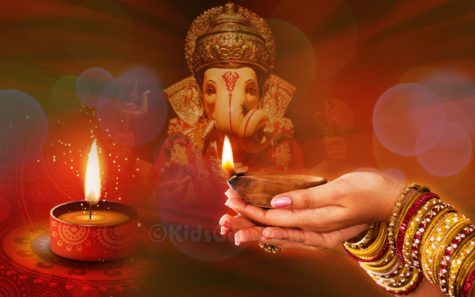
Creating a home shrine is not difficult. The altar should be close to the floor if you plan to use it for puja and/or meditation. However when there are small children in the home it is often best to have it higher and out of reach.
For a Ganesha shrine, an image, or murti, of Lord Ganesha is placed at the center of the altar. A metal or stone image is best, but if not available there are two traditional alternatives:
- A framed picture, preferably with a sheet of copper on the back.
- A kumbha, which is a symbol of Ganesha made by placing a coconut on a brass pot of water with five mango leaves inserted between the coconut and the pot. The coconut should be husked but still have the fibers on the top.
Bathing the God’s image (murti) is a part of a puja and other ceremonies. For this, special arrangements may need to be made. Most simply, the murti may be placed in a deep tray to catch the water. After the bath, the tray is removed and the murti dried off, and then dressed and decorated.
Various items for the altar can include:
- Water cups and a small spoon for offering water
- A brass vessel of unbroken, uncooked rice mixed with enough turmeric to turn the rice yellow
- A tray or basket of freshly picked flowers (without stems) or loose flower petals
- A lamp
- Small metal bell
- Incense burner and a few sticks of incense
- Fresh fruit
Borrowed from The Prosperity Project
The Symbolic Representation of Ganesha
Ganesha is depicted small in stature, with a large, round abdomen, with four arms and the head of an elephant with a single tusk. In three of his hands he is holds an axe (ankush), a noose (sash) and sometimes a seashell. In some representations, with the fourth hand, he makes a gesture granting his divine favor, but more often he is holding a ladhu, a chickpea cookie. His eyes shine like two precious stones. He is riding or is accompanied by a rat, a former demon which he defeated and then accepted as his vehicle.
This representation may not be very attractive for the rational mind. His animal head and fat body attract children but for those who consider themselves to be adults, he seems ridiculous. It is a mistake however to deceive ourselves by his appearance, because Ganesha is the patron of refined beings who are not deceived by outer appearances. However those who cannot see the Divine in him and are distracted by his representation, become pray for the discursive mind, which represents the greatest obstacle on the spiritual path.
Accepting Ganesha as a Divine Force has the effect of controlling and calming the mind as well as in dissipating doubts. This is why he is considered to be the most suitable deity for removing obstacles. Believing in him generates a huge force, reversing the usual downward flow of energy, orientating it upwards and thus allowing the activation of the superior centers of force in our being. The divine Ganesha is unbreakable. He grants firmness to those who meditate upon him and invoke him at the beginning of all profane or spiritual actions.
In Mugdala Purana it is said: “Ganesha’s human body represents «tvam» (you), the elephant’s head is «tat» (Brahman) and together they signify the unity between these two aspects. Therefore Ganesha’s body is the visible representation of the highest reality, Brahman, expressed by «tat tvam asi» (you are That (Brahman or God)).”
Another explanation is that, generally, Ganesha’s head represents Atman, the Supreme Reality while his body, from the neck down, symbolizes maya, the principle of phenomenal existence. The involvement of Atman in the world is realized through mind and speech.
Article taken from Yoga Magazine magazine, issue no. 23
Why Ganesha Has An Elephant Head
There are of course many esoteric explanations regarding the elephant head. An elephant is strong, but always calm. It is one of the few animals conscious of itself and which even has funerary rituals. Despite its force, it is vegetarian.
Puranas offer many versions with regard to Ganesha’s birth and origins of his elephant head. In Shiva Purana it is told that he was created out of an ointment for washing(ubtan) which Parvati, the Divine Mother, took from her body. It is said that one day, as Parvati was preparing to take a bath, she became aware that the guardian of her apartments was missing. She then took a part of the soap from her body, molded it into the shape of a child and blew vital force, prana, onto it. She charged this child to be her guardian and instructed him not to allow anyone to enter the palace.
The child-guard respected his mother’s words and sat outside, with the scepter in his hand. Exactly then, Shiva chose to visit his beloved wife, Parvati, and he came to the palace. Because the little guard prevented him from entering, Shiva got angry and threatened the boy but he was unflinching and only with the support of demons and gods together he could be defeated. Shiva became so furious, that he cut off the boy’s head with his trident.
When the Divine Mother discovered what had happened she was very sad and asked Shiva to bring him back to life. Shiva started to search for the first child sleeping orientated towards the north in order to cut his head off and place on the lifeless body. It was night and all the mothers were sleeping holding the children tight in their arms and therefore Shiva could not take the head of any child. However he saw an elephant calf sleeping alongside its mother, back to back, and decided to take advantage of this opportunity. Therefore he took the head of the elephant calf and joined it to the guardian child’s body, thus bringing him back to life.
Shiva named the boy Ganapati, leader of his troops and decided that every man should adore him before conducting any major action.
Another version states that Ganesha was born as a favor granted to Parvati, following her prayers to Vishnu. The Divine Mother then invited all gods and demigods to come visit her child. They came looking to the child full of concern – all of them except for Shani (Saturn), who looked into the ground because he had been cursed by his wife that any being that looked upon would be transformed into ashes.
The Divine Mother was convinced, however, that her baby could not be harmed by Shani’s eyes and despite the curse and she beseeched him again to look at the child and bless him. The moment that Shani looked at the baby, he head turned into ashes. Vishnu flew away riding Garuda (the god with an eagle’s head, his traditional vehicle), searching for a child in order to bring its head, according to Brahma’s indications. The head he found was that of an elephant calf.
There are many other stories from various ages (kalpas), regarding Ganesha’s birth but they all reveal the fact that he is a creation of the Divine Force, either Shiva or Shakti. Ganesha was created in order to guard the Divine Mother’s palace. So he is the only one that can allow us to get to Her.
Article taken from Yoga Magazine magazine, issue no. 23
Shri Ganesha Upanishad
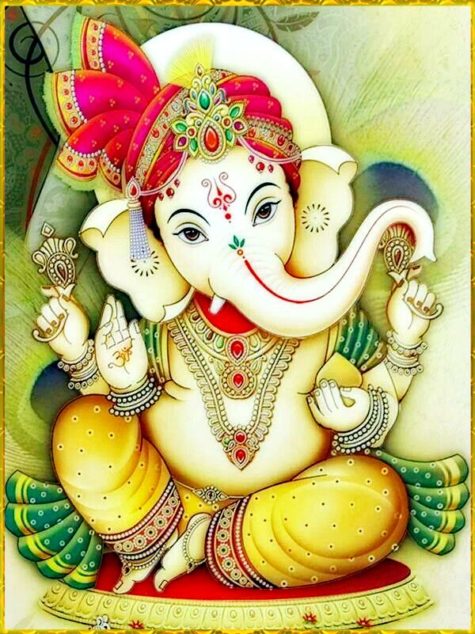
Aum! Let us listen with our ears to that which is auspicious, adorable one. Let us perceive with our eyes what is holy and auspicious. With strong, stable body and limbs, may we seek the divine grace and accept the noble order of all our life.
I surrender to you, Lord Ganesha. You are the speaker. You are the listener. You are the giver. You are the sustainer. I am your disciple. Protect me from the front and back. Protect me from the north and the south, from above and below. Protect me from all directions.
You are full of perfect knowledge of truth and awareness. You are full of bliss and pure consciousness. You are truth, consciousness and bliss. You are the absolute awareness. You are full of supreme wisdom and knowledge.
You are the earth, water, fire, air and the space. You are the root foundation of speech. You are beyond the three gunas: sattva, rajas, and tamas. You are beyond the physical, mental, and causal bodies. You are beyond the three aspects of time: past, present, and future. You are eternally established in the muladhara chakra. You have three shaktis: action, knowledge, and will.
Salutation to the Ganapati whose seed mantra is Aum Gam. We know Ekadanta, the One-tusked God, the unique God. We meditate upon Vakratunda, the curved-trunk God. May that unique elephant God illumine our consciousness and direct us along the right track.
One should meditate upon Lord Ganesha having one tusk and four arms; holding the noose and goad with two of them; with the other two indicating varada, the giving of boons and blessings, and abhaya mudra, the fear removing gesture; having a mouse as the emblem on his ensign; possessing a big, beautiful belly and large, lovely ears which look like winnowing baskets; having a red cloth and His whole body covered with red sandalwood paste. He should be worshiped with red flowers. He manifests Himself as the universe and is beyond pakriti, matter, and Parusha, the manifest God. One who worships Ganesha in this way forever is the best of yogis.
Prostrations to Vratapati, the Lord of Plenty. Prostrations to Ganapati, the Lord of various groups of Gods. Prostrations to Pramathapati, the Lord of Shiva’s hosts. Prostrations to Lambodara, the full-bellied God with a single tusk, destroyer of obstacles, the Son of Shiva, the Bestower of all Blessings.
He who chants this Ganapati Upanishad will verily get established in Brahman, the pure awareness. He will never encounter any obstacles. He will be happy everywhere. He will be free from the five great sins and lesser ones. By reciting this in the evening, the day’s sins are destroyed.
By reciting this in the early morning, one becomes free from the sins committed at night in dreams. Reciting this morning and evening, one becomes totally free from all sins. He becomes totally free from all obstacles. He achieves the four divine ends of life: dharma, artha, kama, and moksha; virtue, wealth, pleasure, and liberation.
Aum Ganesha saranam saranam Ganesha.
Excerpted from Ganapatyatharsirsham
Translation by Dr. Vasant Lad
Ganesha Road Opener Blend
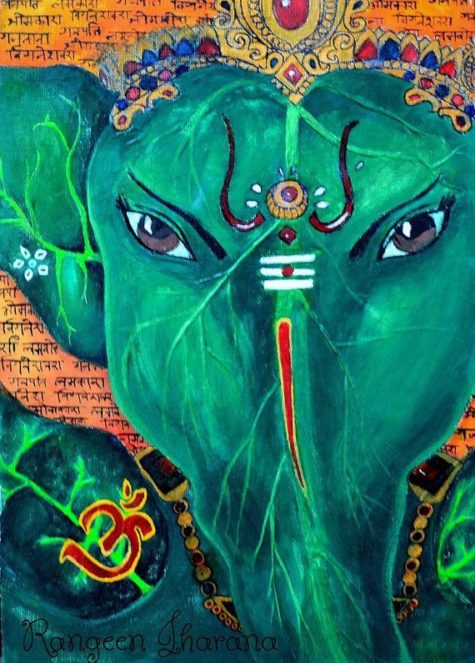
Fill a small bottle with equal parts of the following essential oils:
- Sandalwood
- Honeysuckle
- Hibiscus
Add a few drops of Gardenia essential oil.
Consider all obstacles in your way being removed from your path as you blend this oil, and invoke Ganesha, the remover of obstacles to give his blessings to your blend so that it may be the best oil you use to open all roads to success.
You can use Ganesha Road Opener Oil in a variety of ways. It can be worn on the body, dabbed into the bath, anointed on important documents, dropped in the heel of your shoe, dabbed on charms and talismans, rubbed on the front door, burned in a diffuser or simply worn during prayer or meditation. You may also petition Ganesha by placing out sweets, fresh flowers and a bowl of water with a bit of this oil blend mixed in.
This oil blend should be a basic staple in your collection, and I strongly suggest you keep it on hand to be used whenever needed. Anytime you must clear your way through physical obstacles, this is the oil for the job. Add Road Opener to any magick or impossible task you wish to accomplish.
Add this oil to liquid body soap, and every time you wash your hands, you will be imbuing them with the power to open roads in all that they encounter. Writing letters, doing chores and being involved in all manner of communications – we use our hands one way or another.
Adapted from a recipe in the Enchanted Formulary
A Ganesha Road Opener Ritual
If you are seeking new opportunities and wish to break down any obstacles that stand in your way, a Ganesha Road Opener Ritual just may be your answer!
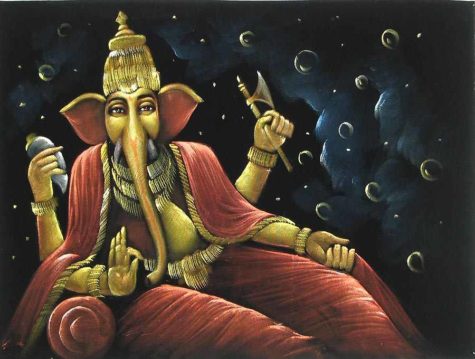
To perform a Ganesha Road Opener Ritual, print out a picture of Ganesha and place it on an altar. You will also need a yellow candle, candy, a simple plate, a bowl of fresh water and some fresh flowers. Begin by cutting the flowers and placing them in the bowl of fresh water. I prefer to cut the flowers down to simply the flower tops and allow them to float in the water.
You will also want to add a couple drops of Ganesha Oil into the water as you do this. On your plate, place any items that reflect what you wish to accomplish. For example, you can place your business cards, some new silver coins, a job application, a prayer, petition, photos or even an important business contract. Get your yellow candle and anoint it with Ganesha oil, drawing the oil up the candle towards the wick.
- Here’s a recipe if you want to make it for yourself: Ganesha Road Opener Oil Blend
- Calamint, Sandalwood, and Hibiscus essential oils, hydrosols, or fragrances can be substituted for an oil blend.
- Sesame oil can also be used as a substitute.
Place the candle in an appropriate candle holder and then put it on the plate with your items. When you are ready, light the candle and say a prayer. When the candle has completely burned down, take all the remains and bury it in a flower pot.
Here is the easiest and most effective way to ask Ganesha for help:
- First study a picture of Ganesha, so that you may have a firm understanding of what he looks like and can recreate that image in your mind.
- Take a few deep breaths, close your eyes and bring that image of Ganesha to your mind. Try and see him in as much detail as possible. See his beautiful elephant-head, with welcoming eyes, large ears, long trunk and big, pot-belly. See him as clearly as you can.
- Now, simply speak to him, speak all of your concerns, worries, needs, etc. Know that as you speak he is hearing you and that you are making a connection with him.
That’s it! It’s that easy. When you have done this once, it is said that you will then have a permanent and ongoing relationship and connection with Ganesha. Speak to Him anytime you wish, as many times as you wish. It does not have to be a formal meditation. Take a moment in your day, if you feel the need, close your eyes and speak to him using the above method.
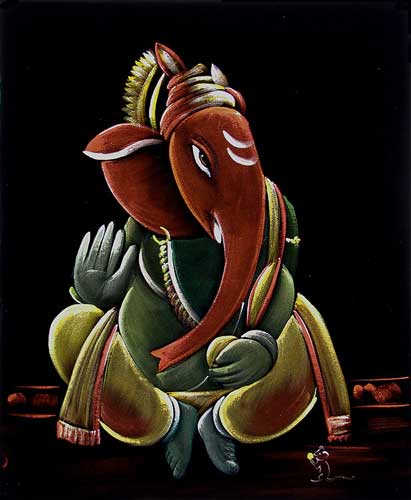
Invoking Ganesha With A Mantra
Another way that you can invoke the power of Ganesha is by repeating one of his mantras. In the simplest sense, mantras are ancient Sanskrit words of power. Each syllable of a mantra resonates a certain vibration. Mantras are used in meditation, to focus the mind, but they are also used to invoke the blessing of a Deity.
- A variety of Ganesha Mantras can be found here.
What is happening when you repeat a mantra over and over, is that you are matching your own vibrational frequency to that of the mantra and its purpose (wealth, health, success, knowledge, etc.). Each of the Hindu Deities has their own mantra or mantras, which invoke the type of energy that the Deity represents.
Collected from various sources
What Is Grace?
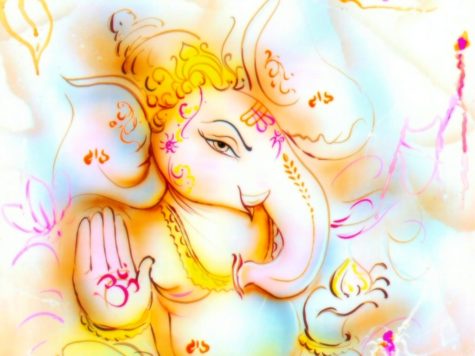
“What about the grace of the Diety?” seekers ask. Grace is received from the God when you are consistent in your worship, consistent in your discipline, consistent in your bhakti, your devotion.
With such a foundation in your life, a great shakti, a force or power, will come from Lord Ganesha. This is grace. It is uplifting. It comes unexpectedly. When grace comes, your mind may change and your heart may melt. Your sight will become clear and penetrating. You may say. “I have been graced to see everything differently.” New doors will begin to open for you, and as you go through them, your life will become more full, more wonderful. And the grace of it is that it would not have ordinarily happened to you.
Seekers also inquire, “What is the difference between grace and a boon from the Gods?” Grace is not exactly a boon. A boon comes as the result of something that you ask for and receive. A boon is quite specific. Grace comes because of the state of the soul in conjunction with its particular karma. It comes because we have done everything right up to a certain point in time according to the laws of dharma. It is then that the grace of the God comes.
Grace is not for a specific need or event in your life, as a boon would be. Grace is more of a complete transformation – a metamorphosis. After receiving grace of a God, the devotee can never be the same again, never look at life again in the old way.
By grace we are directed deeper into spiritual life, pointed in the right direction, carefully guided on the San Marga, the straight path to your supreme God. After grace has been received, our thoughts are enlivened, our life is inspired with enthusiasm and energy, and we live daily in the joyous knowledge that everything is all right, everything is happening around us in accord with our karma, our dharma, and God’s gracious will.
from Loving Ganesa
by Satguru Sivaya Subramuniyaswami
Praying To Ganesha
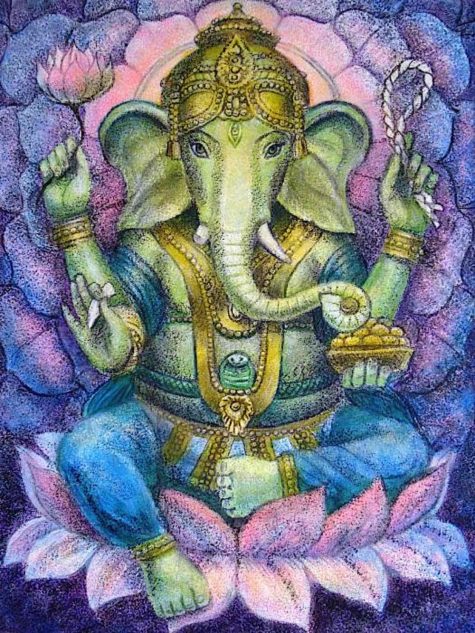
Prayers of supplication are requests, pleadings, or entreaties presented to the Deity in the spirit of personal surrender and loving devotion. Something specific is being asked for, a specific problem is being laid at the Lord’s Holy Feet.
Such supplications to the one-tusked Lord are given unconditionally, with full trust that He will do what is best for us, though not necessarily what we might think is best. We do not demand of the Lord; for He, like a parent, provides not as we desire, but as we truly need. Prayers of supplication may come forth in the natural language of our hearts.
Leaving a problem at His holy feet means we let it be there and do not carry it home with us. Nor do we worry or wonder about how it will be handled, when it will be taken care of, or if it will be taken care of at all. In full unquenchable faith we leave the matter there, at the feet of the God, and walk away from the temple or the shrine, feeling that release has started and solution will be forthcoming. We must have this kind of faith for religion to work within us.
To carry home with us the same problems, fears, and worries would be to take back the offering we have given the Deity to dissolve. This is like the rich and famous who buy with gifts and do not give at all, slyly expecting more than something in exchange, gaining papa rather than punya and not knowing the difference. The course of events later show how He works for our ultimate spiritual welfare.
from Loving Ganesa
by Satguru Sivaya Subramuniyaswami
